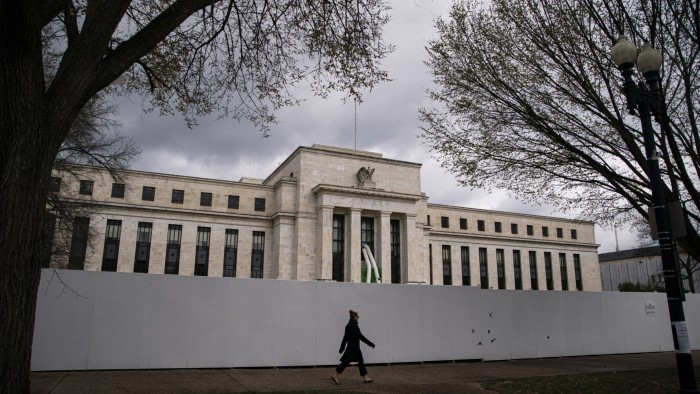Jump in US overnight lending rates awakens fears of money market strains

Simply sign up to the US interest rates myFT Digest -- delivered directly to your inbox.
A brief jump in US overnight lending rates this month is a likely harbinger of strains in money markets next year as the US government sells more Treasuries to cover its deficits, analysts have warned.
Concerns were sparked by a sudden rise early this month in the rate for borrowing cash overnight in the market for short-term funds, a move that was not mirrored in the rate charged by the Federal Reserve to take in excess cash.
A divergence between the two rates, which historically track each other closely, has raised fears over the potential for broader strains in the market lending rates for banks and customers, as cash becomes scarcer after years of excess liquidity.
“The real issue is whether you’re getting generalised funding pressure, or episodic as we saw here,” Joseph Abate, interest rate strategist at Barclays. “My sense is that it probably becomes more generalised.”
The sudden flicker at the start of December has increased attention on a corner of the money markets known as the repo, or repurchase, market. This acts as a benchmark for broader lending, from bank credit to leveraged trades, by setting the short-term cost of swapping high-quality collateral such as Treasuries for cash.
Repo rates and central bank policy rates historically track each other closely but the signal sent by the repo market has been largely distorted during the past decade because the Fed flooded the system with cash by buying trillions of dollars of Treasuries. Money market funds parked that surfeit of cash overnight at the Fed.
But since the Fed stopped buying Treasuries 18 months ago, investors have been left to pick up the slack. This has raised concerns that the increased supply of Treasuries expected in 2024 will overwhelm the shrinking pool of spare funds, straining liquidity in money markets.
“People have maybe forgotten that this is what the repo market does — it sends signals about financial liquidity,” said George Pearkes, macro strategist at Bespoke Investment Group.
If the Fed takes too much liquidity from the financial system, “we’ll know that if repo acts up,” Pearkes added.
For the Fed, the issue is judging the optimum level of liquidity in the market. Central bankers fear too much will encourage speculation and risk-taking, while too little could choke off lending and economic growth.
In the move earlier this month, the secured overnight borrowing rate, or Sofr, rose as much as 0.09 percentage points above the 5.3 per cent paid by the Fed to users of its overnight reverse repurchase facility.
Analysts put the temporary jump down to a glut of new Treasuries, which briefly outstripped the cash available in the market for lending.
Although Sofr has since returned a more normal spread, the incident sparked memories of the market dislocation of September 2019, when soaring repo rates caught the Fed off-guard and forced it to flood markets with billions of dollars of additional cash.
“What happened is important because it hints at what is likely to come and that is more upward funding pressure,” said Mark Cabana, head of US rates strategy at Bank of America. “Do I think that the Fed took notice? Yes. Do I think that they lost sleep? No. But I do think it probably helped advance attention on money markets.”
If rates are squeezed sharply higher or stay high for a prolonged period, it could send shockwaves through the financial system by raising borrowing costs and squeezing the profitability of leveraged trading positions.
Efrain Tejada, rates strategist at Morgan Stanley said the rise had shocked investors who are used to steadier Sofr rates.
“It was to be expected at some point as we see demand for repo financing having gone up — and continuing to rise — while we’re also seeing cash balances coming down.”
One indication of excess liquidity in the financial system is the money parked at the Fed in its overnight reverse repo facility. Balances have fallen from a peak of $2.6tn at the end of last year to about $769bn currently as rising rates on other short-term instruments, such as Treasury bills, have lured investors into more profitable trades.
Key for money-market functioning next year will be the pace at which RRP continues to fall as well as how easily markets are able to cope with the rise in Treasury issuance.
On average, the Treasury will have to raise the size of its regular sales by more than 20 per cent in 2024, analysts have estimated.
Another factor for money markets next year will be the Fed’s programme of quantitative tightening, or QT, through which it is reducing the portfolio of Treasuries and mortgage-backed bonds it acquired after the 2008 financial crisis.
In June 2022 it stopped replacing securities that mature — reducing general demand for bonds by $95bn a month.
Analysts are divided on when the Fed may slow or pause its QT programme, but they do agree that a jump in repo market rates could force the central bank to bolster liquidity in some way as it had to in 2019 because of the risk of strains to the wider financial system.
Although the Fed has since introduced a standing repo facility to help the market in times of sudden strain, most expect that would help ease, but not entirely remove, any rise in rates.
“Nothing cures leverage like high repo rates. People funding trades are willing to accept it if they perceive it to be transitory so when you average it over, say, a month, it’s minimal,” added Abate. “It’s when the funding pressure persists that it becomes more of a deleveraging event and regulators have recollections of 2019.”
Comments